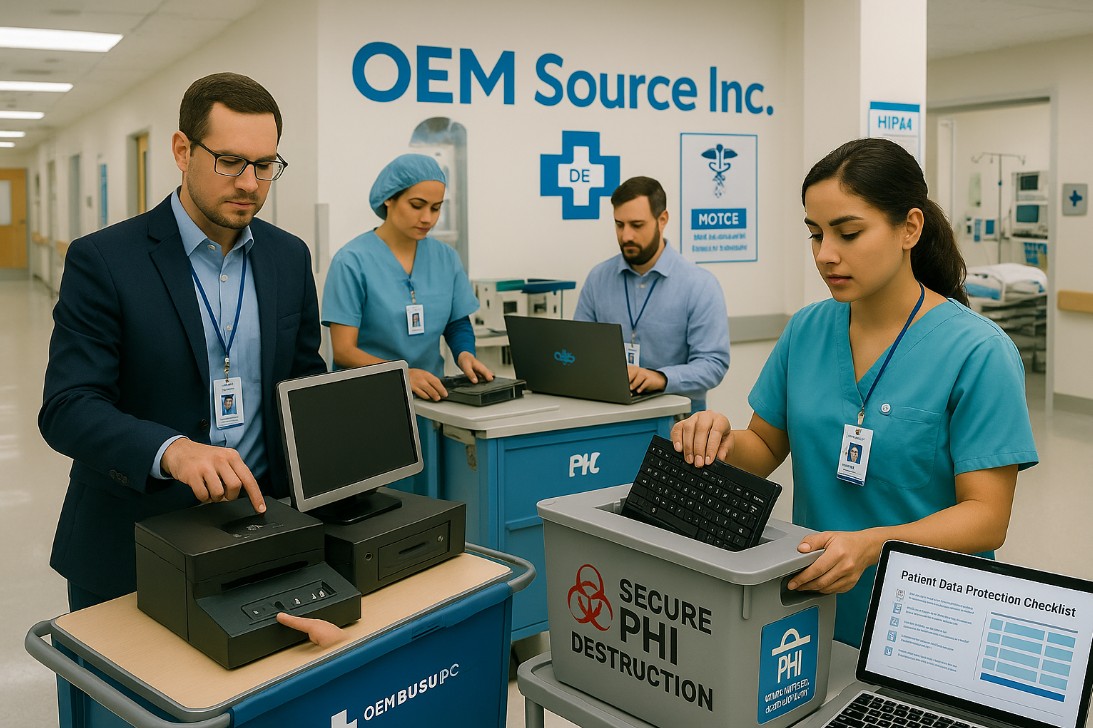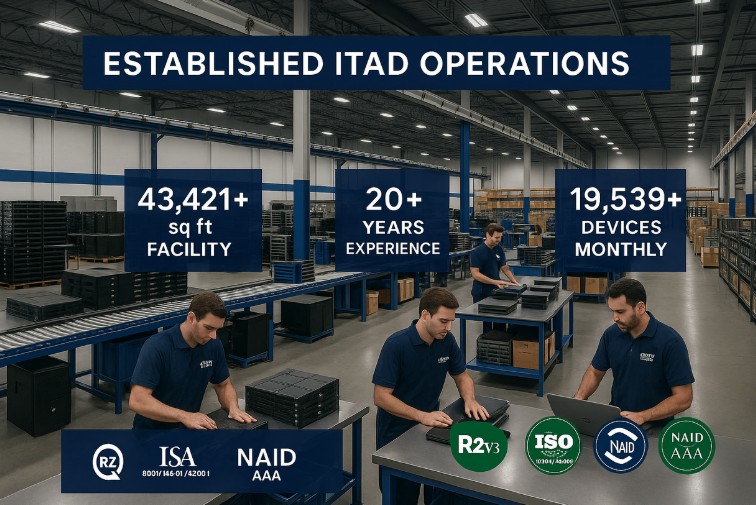Picture this: A major healthcare system’s IT director receives an urgent call at 2 AM. Their organization just discovered that decommissioned servers containing thousands of patient records were improperly disposed of six months ago, and protected health information may have been compromised. The potential fines? Up to $1.5 million per violation, with some healthcare breaches costing organizations an average of $4.45 million in 2023. This nightmare scenario illustrates why HIPAA-compliant IT asset disposal is a critical safeguard that protects both patient privacy and organizational survival.
Healthcare organizations generate massive amounts of electronic protected health information (ePHI) stored across a wide range of devices. When these assets reach end-of-life, improper disposal can expose sensitive patient data and result in devastating financial penalties. The ITAD market is expected to grow from $12.42 billion in 2023 to $18.91 billion by 2028, driven largely by increasing compliance requirements across healthcare and other regulated industries.
Understanding HIPAA Regulations
The Health Insurance Portability and Accountability Act (HIPAA) establishes comprehensive requirements for protecting patient information throughout its entire lifecycle—including the critical disposal phase.
Overview of HIPAA Compliance
HIPAA compliance encompasses multiple interconnected rules that govern how healthcare organizations handle protected health information. The HIPAA Security Rule requires covered entities to implement administrative, physical, and technical safeguards to protect ePHI from unauthorized access. These requirements extend beyond active data usage to include secure disposal methods that ensure complete data sanitization when IT assets are retired.
Importance of Protecting ePHI
Electronic protected health information represents one of the most valuable and sensitive data types in the digital economy. Patient records contain comprehensive personal details, including medical histories, treatment plans, insurance information, and financial data, all of which criminals can exploit for identity theft and insurance fraud.
The Office for Civil Rights has consistently emphasized that ePHI protection requirements apply regardless of the data’s location or storage medium. Healthcare organizations remain responsible for patient information security even when data resides on decommissioned equipment awaiting disposal.
Importance of HIPAA-Compliant IT Asset Disposal
The intersection of healthcare technology advancement and regulatory compliance creates complex challenges that require specialized expertise and proven methodologies.
Risks of Improper Disposal
Healthcare organizations face severe consequences when IT asset disposal practices fail to meet HIPAA requirements. Violations can cost millions of dollars or up to 4% of an organization’s global revenue creating financial burdens that can threaten organizational sustainability. The risks include:
- Regulatory Investigations – Office for Civil Rights audits and enforcement actions
- Legal Liability – Patient lawsuits and class action litigation
- Reputational Damage – Media coverage and loss of community trust
- Operational Disruption – Investigation requirements and remediation efforts
- Competitive Disadvantage – Loss of referrals and partnership opportunities
- Insurance Implications – Increased premiums and coverage limitations
Benefits of Compliance
Organizations that implement comprehensive HIPAA-compliant disposal practices gain significant advantages beyond regulatory adherence. Proper asset disposal demonstrates a clear organizational commitment to patient privacy, enhances operational efficiency, and supports sustainability objectives. Compliance benefits include:
- Improved data security posture
- Streamlined audit processes
- Documented chain of custody procedures that provide legal protection
Role of IT Asset Disposition (ITAD)
Professional IT Asset Disposition services provide the specialized expertise and infrastructure necessary to meet complex healthcare compliance requirements while maximizing value recovery.
Definition and Purpose of ITAD
IT Asset Disposition encompasses the comprehensive management of end-of-life technology assets through secure, compliant, and environmentally responsible processes. ITAD providers offer integrated services including:
- Asset evaluation
- Data destruction
- Refurbishment
- Resale
- Recycling
North America dominates the ITAD market and is projected to reach $10.15 billion by 2029, with a growth rate of 6.8% reflecting growing demand for professional asset management services.
How ITAD Supports HIPAA Compliance
Professional ITAD providers offer specialized capabilities that healthcare organizations typically cannot develop internally. These services include:
- Certified data destruction methods
- Comprehensive documentation
- Chain of custody protocols
- Regulatory expertise to ensure compliance with evolving requirements
ITAD providers maintain multiple industry certifications and provide detailed reporting that supports audit requirements.
Key Certifications for Asset Recyclers
Healthcare organizations must partner with ITAD providers that maintain appropriate certifications and demonstrate proven expertise in handling sensitive data securely.
Recognizing R2 Certification
The Responsible Recycling (R2) certification represents the gold standard for electronics recycling and data security. R2-certified facilities must demonstrate:
- Environmental Management Systems – Comprehensive environmental protection protocols
- Worker Health and Safety Programs – Occupational safety and training requirements
- Data Security Protocols – Stringent information protection and destruction procedures
- Chain of Custody Documentation – Detailed tracking and accountability systems
- Regular Audits – Ongoing verification of compliance and performance standards
- Downstream Responsibility – Accountability for proper handling throughout the recycling chain
Importance of NAID AAA Certification
The National Association for Information Destruction (NAID) AAA certification specifically addresses data destruction requirements for organizations handling sensitive information. NAID AAA-certified facilities demonstrate:
- Proven Data Destruction Expertise – Verified competency in secure sanitization methods
- Comprehensive Quality Assurance – Systematic quality control and verification procedures
- Employee Background Checks – Thorough vetting of personnel handling sensitive data
- Regular Audit Requirements – Ongoing verification of processes and procedures
- Certificate of Destruction – Legal documentation of proper data sanitization
- Industry Best Practices – Adherence to established standards and methodologies
ISO 14001 and Environmental Standards
ISO 14001 certification demonstrates organizational commitment to environmental management systems that minimize ecological impact. Around 50% of organizations need sustainability reporting based on IT equipment disposal, making environmental certifications increasingly important for vendor selection.
Utilizing NIST Guidelines for Data Sanitization
The National Institute of Standards and Technology provides comprehensive frameworks for secure data sanitization that align with healthcare compliance requirements.
Overview of NIST Sanitization Framework
NIST Special Publication 800-88 establishes industry-standard guidelines for media sanitization that ensure complete data destruction across different storage technologies. The framework addresses various sanitization methods, including:
- Clear – Logical techniques applied to sanitize data in all user-addressable storage locations
- Purge – Physical or logical techniques that render target data recovery infeasible using laboratory techniques
- Destroy – Physical techniques that render target data recovery infeasible using any known technique
Ensuring Complete Data Eradication
Complete data eradication requires understanding the technical characteristics of different storage technologies and implementing appropriate destruction methods. The sanitization process must address both logical data removal and physical destruction of storage media when necessary. Organizations must document their sanitization procedures and maintain records that demonstrate compliance with established standards.
Best Practices for HIPAA-Compliant Asset Disposal
Implementing comprehensive best practices ensures consistent compliance while optimizing operational efficiency and cost-effectiveness.
Conducting Regular Risk Assessments
Healthcare organizations must conduct regular risk assessments to evaluate their asset disposal processes and identify potential vulnerabilities. These assessments should examine current procedures, vendor relationships, and documentation practices to ensure ongoing compliance.
Risk assessments should address both technical and administrative aspects of asset disposal, including data inventory procedures, sanitization methods, vendor oversight, and documentation requirements.
Maintaining a Secure Chain of Custody
Secure chain of custody procedures provide essential documentation and control mechanisms that ensure asset security throughout the disposal process. These procedures must address:
- Asset Identification and Inventory – Comprehensive cataloging of all devices containing ePHI
- Secure Transportation – Controlled movement of assets from healthcare facilities to disposal sites
- Processing Documentation – Detailed records of all handling and processing activities
- Destruction Verification – Confirmation of complete data sanitization and physical destruction
- Final Disposition – Documentation of recycling, resale, or disposal outcomes
Obtaining Certificates of Destruction
Certificates of destruction provide essential documentation that demonstrates compliance with data sanitization requirements. These certificates should include detailed information about the destruction methods used, the specific assets processed, and verification of complete data eradication.
Professional ITAD providers typically offer comprehensive certificates that include asset serial numbers, destruction methods, dates of service, and certification of compliance with relevant standards.
Partnering with Certified ITAD Providers
Selecting appropriate ITAD partners requires careful evaluation of certifications, capabilities, and a proven track record in healthcare compliance. Organizations should prioritize providers that maintain multiple relevant certifications and demonstrate specialized expertise in healthcare data security.
Selecting the Right Service Provider
The selection process should include a comprehensive evaluation of provider capabilities, certifications, and compliance track record.
Verifying Provider Credentials
Healthcare organizations must conduct thorough due diligence when selecting ITAD providers. Evaluation should address:
- Certification Verification – Confirmation of current R2, NAID AAA, and ISO certifications
- Insurance Coverage – Adequate liability and cyber insurance protection
- Financial Stability – Demonstrated business continuity and financial strength
- Healthcare Experience – Proven track record with healthcare organizations
- Compliance Expertise – Knowledge of HIPAA and other healthcare regulations
- Geographic Coverage – Service availability across organizational locations
Staff Training and Awareness
Comprehensive staff training ensures consistent implementation of compliant disposal practices across the organization.
Importance of Ongoing Training
Healthcare staff at all levels must understand their roles and responsibilities in maintaining HIPAA compliance during asset disposal. Training programs should cover both general compliance principles and specific procedures for handling end-of-life IT equipment. These programs should be updated regularly to reflect new technologies, evolving risks, and regulatory changes.
Implementing HIPAA Policies
Organizations must develop and implement comprehensive policies addressing all aspects of IT asset disposal. These policies should include clear guidance on:
- Staff responsibilities
- Vendor selection criteria
- Chain of custody procedures
- Documentation requirements
Policy implementation should include routine review and updates to remain aligned with technological changes and evolving compliance standards.
Legal and Environmental Responsibilities
Healthcare organizations must address both regulatory compliance and environmental stewardship in their asset disposal practices.
Understanding Legal Implications
HIPAA violations can result in significant legal consequences, including civil monetary penalties, criminal charges, and corrective action requirements. The Office for Civil Rights can impose penalties ranging from $100 to $50,000 per violation, with annual maximums of $1.5 million. Legal risks extend beyond HIPAA to include state-level privacy laws and environmental protection regulations.
Environmental Considerations in IT Disposal
Environmental regulations such as the Resource Conservation and Recovery Act (RCRA) establish requirements for the handling and disposal of electronic waste. Healthcare organizations must ensure their ITAD practices comply with both federal and state environmental laws while also advancing internal sustainability objectives.
Integration with Other Regulatory Frameworks
Healthcare organizations must navigate multiple regulatory requirements that intersect with IT asset disposal.
Intersection with GDPR
Organizations with international operations must comply with the General Data Protection Regulation (GDPR). GDPR non-compliance can result in fines up to €20,000,000 or 4% of global annual turnover, making international regulatory awareness essential.
Alignment with PCI DSS
Healthcare organizations that process payment card transactions must also comply with the Payment Card Industry Data Security Standard (PCI DSS). These requirements apply to any IT assets that process, store, or transmit payment data, necessitating secure disposal procedures.
Secure, Compliant Disposal Starts with the Right Partner
For healthcare organizations seeking comprehensive IT asset disposal solutions, Data Destruction services provide NAID AAA-certified data sanitization aligned with HIPAA requirements. When managing broader IT infrastructure transitions, Corporate IT Asset Disposition services offer secure, compliant handling of all healthcare technology assets.
Frequently Asked Questions
How should healthcare organizations dispose of IT assets?
Proper IT asset disposal involves asset inventory, risk assessment, certified data destruction, and environmentally responsible recycling. Healthcare organizations should partner with certified ITAD providers that maintain R2, NAID AAA, and other relevant certifications to ensure compliance with HIPAA requirements.
Are IT service providers subject to HIPAA regulations?
Yes. IT service providers that access or manage protected health information on behalf of healthcare organizations are considered business associates under HIPAA. This includes ITAD vendors and data destruction companies, who must meet all applicable privacy and security requirements.
What is the proper way to dispose of HIPAA documents?
All physical and electronic records containing PHI must be destroyed in a manner that prevents unauthorized access or recovery. For paper records, shredding or pulverizing is typically required. For digital records, certified data sanitization or physical destruction of media (e.g., hard drives) is essential.
What documentation is needed to prove HIPAA-compliant disposal?
Healthcare organizations should obtain a Certificate of Destruction from their ITAD provider. This document should detail the date, method of destruction, asset serial numbers, and confirmation that data was irretrievably destroyed according to HIPAA and industry standards.
What are the consequences of non-compliant IT asset disposal under HIPAA?
Improper disposal of IT assets containing PHI can result in severe penalties, including fines of up to $1.5 million per violation and potential civil or criminal liability. In addition to financial repercussions, organizations may face regulatory investigations, reputational damage, and loss of patient trust. HIPAA enforcement applies even if the data exposure occurs months after disposal.





